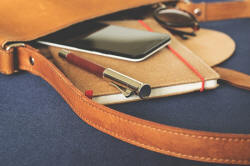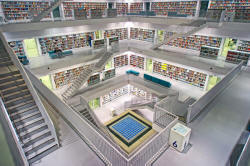Nine types of Resources

Time was, when a blackboard and a piece of chalk was about the limit of resources available to most teachers. In many parts of the world, that's still, unfortunately, true.
 |
Contents |
| boards | data projectors | libraries | smart phones | audio and video | realia | the web | VLEs | learning centres |
We'll take them one at a time and discuss what they are and, when it's appropriate, what they are good for and what they are not good for.
There are separate guides on this site to materials evaluation,
do-it-yourself materials development
and the meaning of authenticity.
None of that will be repeated here.
You can follow the guide all the way through, or use the menu above.
Click on -top- at the end of each sections to
return to this menu.
 |
Boards |
These days boards come in all sorts of shapes, sizes and colours. They can be black, white, green or smart but essentially they all perform the same two important functions:
- as a focus
- as a record
Boards are the central and most versatile aid of all. They
don't have to be interactive (although that helps) and they don't
need to be colourful (although that helps, too) but they do have to
be organised.
The board is often the focus of all or part of every lesson.
It is where the learners look for critical information and it is often from
the board that they note things down to take away. That means:
| What boards are not good for | What boards are good for |
| Jotters and
note pads. If you use the boards like this, it will soon fill up with all kinds of irrelevance. |
Emphasising important things. Learners will naturally believe that what the teacher takes the time to put on the board is important. Most learners will write down whatever the teacher writes on the board. Write irrelevance and that's what the learners will take away. |
| Large quantities of text. | Short model structures and lexis. |
| Random thoughts. | The organised
presentation of ideas and items. If you organise things by position and colour, your learners will get used to knowing where and in what colour to look for models, new words, instructions and so on. |
| The presentation of a complete set of ideas. | Writing long sentences and lots of text on a board is a time-consuming thing to do and a very dull thing to watch. Boards are ideal for presenting the build-up of ideas (such as time lines), much less useful for presenting the 'finished article'. |
| The sole use of the teacher. | Allow your learners to use the board to give feedback. |
 |
Data projectors |
This section applies to visualisers, too. They function
similarly.
Smart boards can, of course, function as data projectors and
projectors are often seen as a replacement for using boards.
They are not (see above).
| What projectors are not good for | What projectors are good for |
| Presenting
long texts for people to work on. It is tiring and frustrating to be asked to read and analyse text projected onto a screen. |
Providing
feedback on text-based tasks. When learners have worked on a text together to find the items which form the targets of the lesson, for example, projecting the 'right answers' is a better way of giving feedback than trying to elicit the answers and get all the people in the room to follow what's going on. |
| Individualising
tasks and input. By their nature, projectors provide data to everyone in the room. Being asked only to select what is useful for you, your pair or your group is not a good use of the aid. |
Focus for the
group. By their nature data projectors function as boards do to focus everyone on the same data. |
| Presenting
small graphics. Something that is easy to discern on paper is surprisingly difficult to locate and identify when projected. |
Presenting
engaging large images. Projectors are ideal for a replacement of the old walk-round-the-class-showing-everyone-the-picture routine. With a projector, everyone sees it together. |
| Unprepared
input. You may have a laptop or whatever connected to your data projector or smart board but using it for off-the-cuff explanations is perilous. The board is a better option. |
Prepared
materials. Projectors are the ideal way to avoid writing too much on the board (and wasting everyone's time). PowerPoint or similar programs are well-suited to the preparation of data but need to be handed with care. They are not good for lots of data. Giving feedback to tasks via a projected set of answers or a text is time-efficient and focused. |
| The sole use of the teacher. | If you have a visualiser or can connect the learners' various devices to your projector, it is motivating and engaging for them to see their contribution(s) displayed for all to see. |
 |
Libraries |
The best way to improve your
knowledge of a foreign language is to go and live among its
speakers. The next best way is to read extensively in it.
Nuttall, 1982:128
Libraries do not have be extensive or expensive (see picture). They can
be as simple as you like, containing a few books for people in the
class to share, or a school / institution-wide resource for all to
use.
Electronically stored data is convenient to use and has many
advantages but people like books.
Encouraging extensive reading by providing, and using, the resources
for it has many supposed benefits, not least that:
- Frequent readers have better vocabulary
- Frequent readers use grammar more accurately
- Frequent readers have positive feeling about the language
- Frequent readers show higher motivation
- Frequent readers have better listening, speaking and writing skills
Of course, the direction of causality is an issue here. Is it that frequent reading encourages motivation etc. or that more motivated learners are likely to read more etc.?
For what might usefully go into a library, see below in the section on Self-access Learning Centres.
 |
Smart phones |
These are underused but most students have them. Their main boon in the classroom is that they can be used to record students talking and to take quick images. You need to consider carefully how that is done and how you will listen to / see the results.
| What smart phones are not good for | What smart phones are good for |
| Taking the
place of proper recording equipment. Technically, it can be trying and frustrating to link phones to other projection devices. It rarely works well. |
Project and
other discovery work outside the classroom. It is rewarding, engaging and often motivating to get students to research the environment and the people in it to report back to the group. Smart phones, which can record both images and audio are ideal ways to store data. |
| As
go-to-dictionaries. Many smart phones now contain translating data and those can be useful but, just like dictionary use, learners need to be taught how to use the data. |
As part of
dictionary training. Smart phones and electronic dictionaries are not going away any time soon. The attempt to ban them in classrooms is probably futile and counter-productive. What learners need is training in their use. |
 |
Audio and video recording / playing |
There are two different ways to use these:
- As input materials:
Language teachers have long used these aids and, with DVD players and CD players, they have become easier to use. The trick is to be fully acquainted with the equipment so you don't waste time playing with the controls and trying to find the bit on the CD you want to play. Practise.
Beware, too, of overly long sequences. The maximum is around 5 minutes before audio recordings start to wash over people or video recordings become just passively watching TV. At lower levels, one minute is probably the limit.
You need to set the learners clear tasks to achieve before they listen or watch, while they are listening or watching and after they have listened and watched. Make sure there is a purpose to it.
These are aids, not substitutes for the teacher. - To record learners' output:
This use needs a bit more care and expertise to set up but it can be very rewarding to hear oneself speaking a foreign language accurately and comprehensibly. On the other hand, it can be acutely embarrassing to hear oneself speaking it poorly and incomprehensibly.
Handle with care.
 |
Realia and the real world |
Bringing real objects into the classroom can be engaging and motivating (especially if the learners have brought them). Consider, for example,
- Real texts:
A letter / email from a friend or relative of yours or one of the learners is immediately more intriguing than something made up in a coursebook. - Objects:
If your aim is to teach vocabulary for things like fruit, stationery, colours, clothes etc. then having real objects to talk about and describe is motivating and memorable. The same applies to lots of adjective teaching, of course. - Notices, adverts and mini-texts:
Many institutions have places for people to post notices. Exploit them. - Newspapers, brochures and magazines:
can form the basis for a huge range of lessons (not just those focused on reading skills). Get your learners to gather them, if possible. - Don't forget that most of us carry 15 or so items with us at
all times.
In a class of ten, you have a potential 150 objects to talk about, explain and describe. - Personal things:
A useful set of lessons can be built around the learners bringing to class a small object that is, in some way, significant for them and explaining to others what it is, how they acquired it and why it's significant. - Even if you are teaching in a non-English speaking environment
(i.e., you are in the huge majority), there will usually be large
numbers of examples of English-language posters, signs and texts.
Get your learners to gather them up and exploit the language in the classroom.
If you are fortunate enough to be teaching in an English-speaking environment of course, the possibilities and opportunities to interact with the language and its speakers are much greater. Research projects, surveys, service encounters and so on are all exploitable tasks. There is mileage, for example, in sending learners to real service offices (such as estate or travel agencies) to get real information.
 |
The web |
The web is, for many, becoming the real world. Even if you don't have in-class access to the web, there are huge numbers of useful resources out here, not least on this site. However, some words of warning:
- Many websites are not reviewed so they constitute the production of individuals and accuracy and fairness may be problematic.
- Websites may contain copyright materials that you can't simply steal (this one is something of an exception). See the charter for how you may use materials you get from ELT Concourse.
- There are probably millions of lesson ideas and plans out here on various commercial and non-commercial websites. Use them with care or your teaching may become just a series of one-off lessons without direction or purpose. If lessons you get from this site or others fit into your course plan, use them. Otherwise leave them alone.
If you want somewhere to start, the pages for teachers and learners of English on this site may be helpful.
 |
VLEs |
A Virtual Learning Environment is a computer-based classroom, of
sorts.
Programs which allow you to set these things up vary from the hugely
complex (and often expensive) to simple and free.
Typically the programs:
- Give you the ability to present materials via visual, audio or video content (which can be recorded or live)
- Allow you to separate the learners into groups for specific tasks
- Provide ways for learners to submit work and get feedback
- Provide reports on levels of participation and involvement
There's no doubt that VLEs are a boon in certain settings, allowing access to courses and learning that would otherwise be unavailable. As usual, there are two sides to the story:
| In favour of VLEs | Critical of VLEs |
| They economise on time and costs for institutions because no time is used getting to physical sites by either teachers or learners. | They can be used to cut corners and remove the need for staff dedicated to their areas of expertise. |
| They provide great flexibility because learners can access the environment as and when they like. | Learners can feel isolated and bewildered by where to start and what to do. |
| They are familiar ways of operating for learners in the 21st century. | So what? |
| They allow materials to be re-used frequently on different courses without the need for physical copies of the materials to exist at all. | Traditional courses also provide for this and it is not something unique to VLEs. |
| The are student centred and encourage autonomy because learners work at their own pace and take responsibility for their own learning. | They remove all face-to-face interaction. For language teaching, this is especially critical because it is in face-to-face transactions and interactions that much language is used in the real world. |
| They provide a huge storage area for materials, plans and records. | So do laptops and institutional central servers. VLEs also require good levels of IT expertise to keep track of everything. |
VLEs are rarely used in language teaching as a replacement for face-to-face interaction in classrooms but they are frequently integrated into courses.
 |
Learning centres |
These are variously called self-access centres (SACs), learning
and resource centres (LRCs), often combined with libraries (see
above) and so on. We'll stick to the term Learning Centre.
Unlike a VLE, a learning centre has a physical existence. It
can be anything from a small cupboard to an elaborate multimedia
learning centre.
Proponents of Learning Centres will often point to the 'facts' that:
- People learn better when they control the pace and type of learning they do.
- Classroom learning involves being controlled by the pace and interests of the majority of the learners (and the teacher) and that depersonalises the experience.
- Learning centres encourage people to take responsibility for their own learning and that democratises the process.
Even those less enthusiastic about Learning Centres will often agree that they are very helpful resources to supplement what happens in classrooms (or in VLEs, of course).
What one finds in LCs varies dramatically and depends on the resources available to the institution and its level of commitment to the centre. Typically, however, one finds a mixture of authentic, semi-authentic and contrived materials including:
- Print-based materials such as self-study texts, dictionaries, encyclopaedias, journals, magazines newspapers, graded readers and so on
- Audio and video materials including recordings of TV and radio programmes
- Computers with internet access along with tasks to perform and work to do on line
- Quiet study areas and an area to relax and talk to colleagues
Often, as was mentioned above, LCs are combined with libraries.
Using LCs requires a bit of thought.
- Learners need advice, training and encouragement to take advantage of the resources or they can become lost, disheartened and bewildered.
- Many institutions provide explicit guidelines (sometimes called learning threads) to help learners find appropriate materials and resources.
- Some even provide individual counselling to help learners to map out personal ways forward and plans for their own learning.
Reference:
Nuttall, C, 1982, Teaching Reading Skills in a Foreign
Language, Oxford: Heinemann
